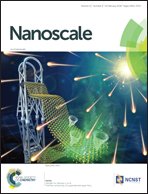In situ probing behaviors of single LiNiO2 nanoparticles by merging CAFM and AM–FM techniques
Abstract
Probing single active nanoparticles of Li-ion battery electrodes is challenging but important to reveal their behaviors including morphology, mechanical properties and electrochemical reactions with an electrolyte. In this work, we in situ investigated voltage-induced behaviors of single LiNiO2 nanoparticles by merging conductive atomic force microscopy (CAFM) and amplitude modulation–frequency modulation (AM–FM) techniques. The former was used to apply a voltage between a selected single nanoparticle and a substrate through its tip, while the latter was done for imaging. Evolution in the morphology and stiffness of the nanoparticles induced by different voltages under air and dried argon atmospheres was tracked, respectively. The evolution mechanisms related to electrochemical reactions were discussed in detail. These results suggest that the merged techniques would provide an indirect and effective approach to study the behaviors and electrochemical reactions of electrode materials on the nanometer scale and even single nanoparticles.



 Please wait while we load your content...
Please wait while we load your content...